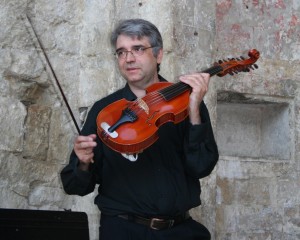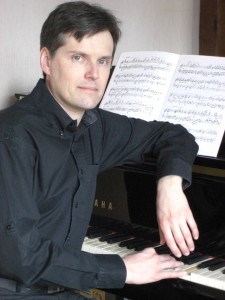Viola and Pianoforte Duo of an exceptionally high standard!
Pierre-Henri Xuereb, a Parisian violist whose descendants are from Gozo, joined forces with another Parisian musician, pianist Pascal Mantin, to regale a sizeable audience which gathered in Aula Mgr G Farrugia for an evening of chamber music.
Schubert’s Sonata in A Minor D.821, known as ‘Arpeggione’, started off the evening. This work, which was composed in Vienna in November 1824, is the only substantial composition for the arpeggione (which was essentially a bowed guitar) which remains extant today. It belongs to the same period as the Death and the Maiden Quartet, when Schubert was suffering from the advanced stages of ill-health and lapsing into increasingly frequent episodes of depression. The piece was probably commissioned by Schubert’s friend Vincenz Schuster, who was a virtuoso of the arpeggione, an instrument which had been invented only the previous year. By the time the sonata was published posthumously in 1871, the enthusiasm for the novelty of the arpeggione had long since vanished, together with the instrument itself. Today, the piece is heard almost exclusively in transcriptions for violoncello and pianoforte or viola and pianoforte that were arranged after that time, although versions that substitute other instruments, including the double bass, the flute, and the clarinet or the guitar for the piano part are also performed.
This is an emotionally complex work, one fully understood by the evening’s performers. Its moods move from deep melancholy to excited ebullience. The opening Allegro moderato is built around a wistful melody whose fame is such that many who have never heard or heard of the Arpeggione Sonata will find that they recognize the tune. A second theme proceeds in gentle gusts of sixteenth notes; the arpeggione could not play fast notes with much volume at all, and so the Sonata‘s quicker portions are almost always marked piano or pianissimo. The Adagio is a rich but introverted musing on an almost hymn-like subject. It comes across as a song without words. Schubert places great emphasis on the Neapolitan chord – a harmony also used to great effect in the opening movement – during the movement’s closing measures, weakening the power of the final cadence and thus inviting the soloist to improvise a brief transition into the final, multi-sectioned Allegretto. The performance was highly polished, with the performers striking an exquisite balance and rapport between them.
Pianist Pascal Mantin is a newcomer to the Festival, and what a pianist he is! Assured, composed and confident he displayed finesse, elegance and power in the two piano pieces he performed next. First came Joseph Vella’s lovely Rapsodija Maltija op.26b. Joseph Vella has proved himself a master of genre. Whatever he writes he is brilliant at. Whether it is a symphony, a concerto, a sonata, a choral work, a chamber piece – the result is one of undisputed excellence. Originally composed for Violin and Pianoforte Duo, Rapsodija Maltija was later transcribed for chamber orchestra and also for pianoforte solo, which we shall be hearing this evening. In the original duo formation, the work is dedicated to Axel Schwirtz, one time cultural attaché at the German Embassy in Malta. It was commissioned to be played at an exhibition of works by Maltese artists held in Mannheim in 1979 and was premiered by Annaliese Schlicker (Pianoforte) and Hanno Haag (Violin). As a composer, Joseph Vella was never over-enthusiastic about the Maltese folk music tradition, real or imaginary. It is notable that Rapsodija is the only piece in his extensive and varied opus which is based entirely on a few of the traditional ‘Maltese’ melodies available. In fact, it is interesting to note the way the composer treats his material in this regard. Although the folk element is unmistakably present, Joseph Vella does not opt for the usual simplistic approach, so common in this type of work. Rhythms and harmonies used (the latter as particularly found in the middle slow section) are typically his, a fact which in the final count does take the work slightly out of the ‘folk music’ spectrum. Rapsodija Maltija is in free ternary form, and is based on four local folk tunes. Pascal Mantin rose admirably to the demands of the work. Playing it from memory he gave an exquisite interpretation of the work, one imbued with wonderful nuance and finely-etched colour.
Debussy’s L’îsle joyeuse is a formidable work by this Impressionist composer. Inspired by Watteau’s painting Embarkation for Cythere, it is written as a single movement in a highly modified sonata form. Using a technique similar to Chopin’s alteration of sonata form in his Ballades, the lyrical second subject returns at the brilliant conclusion as a fortissimo paean. As in most of Debussy’s compositions, L’îsle joyeuse has an almost orchestral quality, as well as an unrelenting choreographic rhythmic drive. The cumulative effect is perfectly calculated and overwhelmingly successful. A number of hallmarks of Debussy’s mature style – parallel sonorities, whole-tone structures, multiple layers of sound, atmospheric effects, melodic fragmentation – are in full evidence. The evening’s performance of the work was fully of poetry, lyrical and rigorous at the same time. The dynamic range exploited reached the whole tonal gamut of the piano and Pascal thoroughly relished seeking out the full innuendo underlying the work. At once gentle and robust, this was a performance of a very high calibre, one that will remain etched in the audience’s mind for a long time!
Three delectable pieces by Maltese composer Nicolò Isouard from his operas Joconde and Cendrillon followed. A master of the opéra-comique, Isouard was one of the foremost composers of the genre in Paris. These three charming works provided a respite from the demanding works performed during the evening. The last piece on the programme was Beethoven’s set of variations on Mozart’s The Magic Flute. When Beethoven wrote these charming variations on Mozart’s aria (“In Men Who Know the Feeling of Love”) about love sweetening every trouble, he was 31. Some have speculated that he shared Papageno’s yearning for a soul-mate. Ferdinand Ries quipped that he had heard Beethoven had been in love for a particularly long time, “seven whole months.” Whatever the case, Mozart’s music must have impressed Beethoven more than its words. For the sake of thematic consistency, he even leaves out the aria’s most tender moment (when Papageno and Pamina sing “Mann und Weib”). Typically, Beethoven’s variations create a beguiling variety of moods: melancholic, haunting, determined. The final one seems related to the drama and melody of his Sonata for Cello and Piano in F major, op.5 (written a few years earlier) and to the glistening musculature of his later works.
This work brought the recital to a rousing close.








